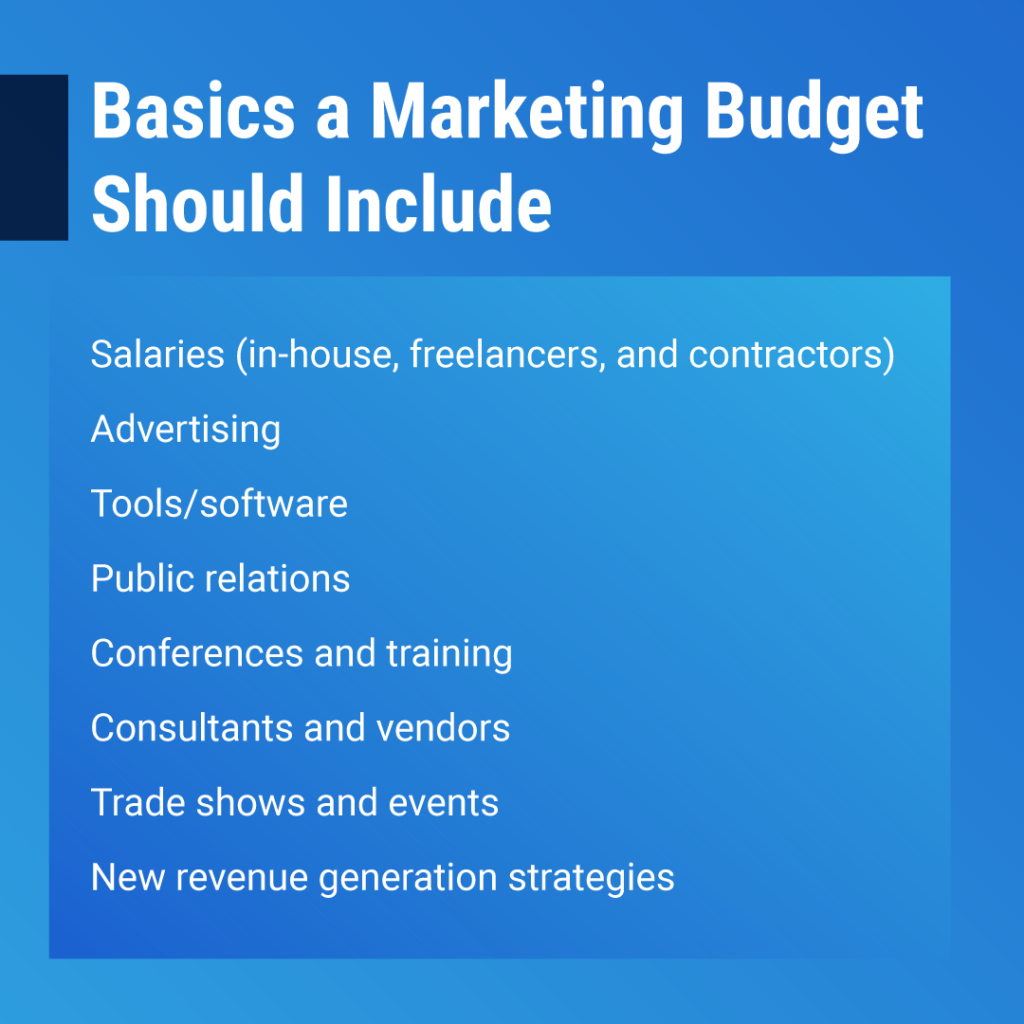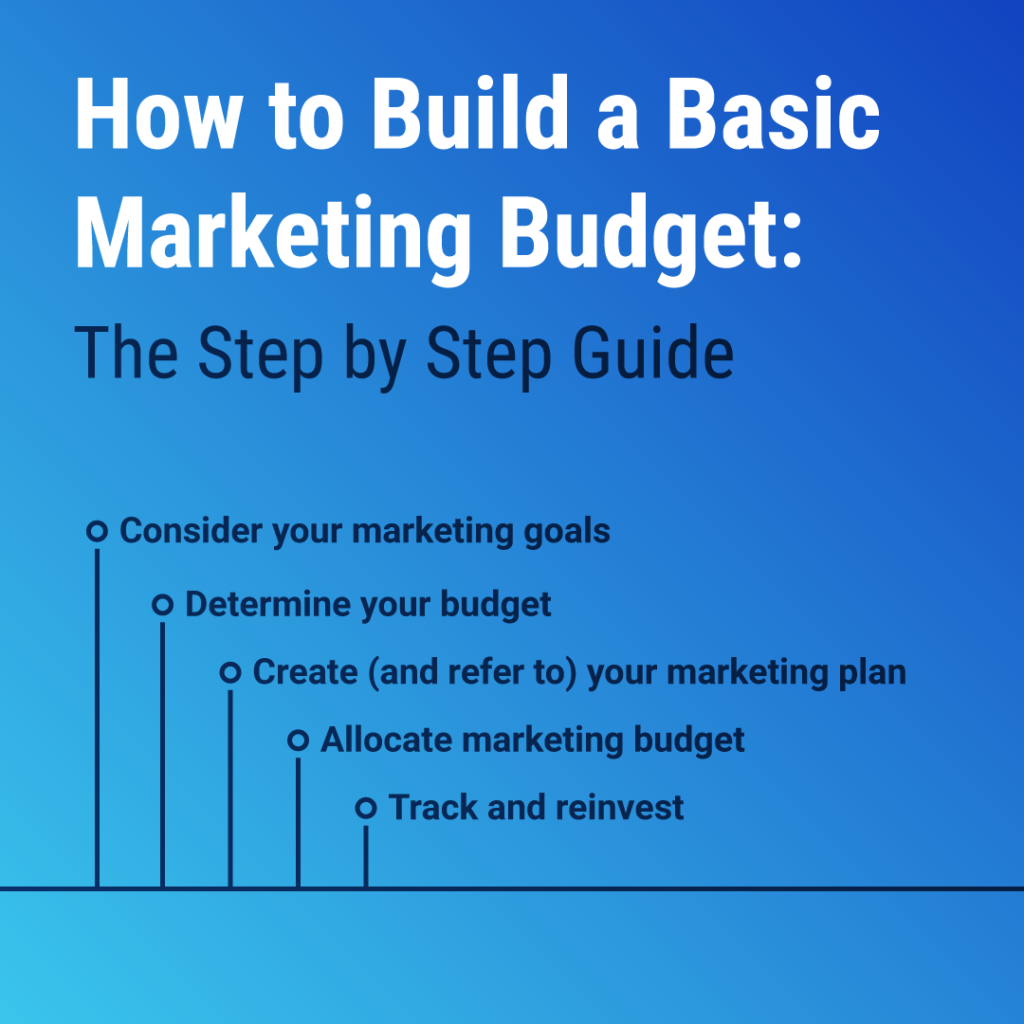Are you on a mission to spend your marketing budget without wasting a single dollar? Then you need to build a marketing budget that will allocate the funds where they are most needed. Budgeting is required to ensure the marketing team does not spend more than its fair share of company resources. It’s easy to get carried away by throwing money at marketing efforts without proper consideration for other departments.
63% of marketers state that their biggest problem is generating leads and driving traffic. Optimizing marketing practices increases both and makes the most of your budget. However, in this guide, we provide tips for building a marketing budget that takes multiple verticals into account, as well as share templates you can download to get started.

What Is a Marketing Budget – And Why Do You Need One?
Marketing budgets determine the amount of money available to spend on marketing-related activities. Typically, the budget is set for a specific period, which could be a quarter or year. Marketing budgets relate to several expense types. This includes:
- Salaries (in-house, freelancers, and contractors)
- Advertising
- Tools/software
- Public relations
- Conferences and training
- Consultants and vendors
- Trade shows and events
- New revenue generation strategies
The importance of the marketing budget stems from company resource allocation. Successful companies cannot throw everything they have into one department. For example, spending too much money on marketing and product development could take a hit. A balancing act is required to use the available funds in a way that puts the company in the best position to flourish.
Creating a marketing budget for small businesses that have limited funds is especially important. They should with business growth for optimal economic stability.
So how much should a company spend on marketing? Well, studies conducted by Gartner found that, in between 2014 and 2020, companies spent 10-12% of their total revenue on marketing. This ballpark figure gives you an idea of how much to spend, but your needs may vary based on company goals.

How to Build a Marketing Budget
The point of marketing is to attract new customers and make a return on investment. The budget ensures that company resources are allocated optimally to meet these goals. Continue reading to learn the step-by-step process of building your marketing budget breakdown.
Step 1: What are your marketing goals?
Before you can allocate a budget, the goals need to be defined. When creating marketing goals consider how much focus is given to generating new customers, securing sales and brand building. Marketing strategies for each of these will differ. For instance, brand building focuses on educational content, whereas landing pages are best for sales.
Initially, goals can be vague, but as they crystalize it’s important to create ones that can be measured to take advantage of analytics. SMART (Specific, measurable, achievable, relevant and time-based) goals is a reliable strategy. Writing down goals could improve your results by up to 20% as a report by Gail Matthews shares.
Step 2: Determine your budget
Now it’s time to look at your books and determine how many resources you have at your disposal. In an ideal world, you would have unlimited resources to bring every marketing idea to life. However, the reality is different and you should hire an account to give you the available funds. They can leave emotion out of the equation and provide an honest amount that you should spend.
Step 3: Create a marketing plan
Come up with a marketing plan that provides an overview of what channels you will be using. In the next section, we will cover how to allocate a budget for each marketing channel. However, the task now is to choose the channels that will spearhead your marketing campaign.
Step 4: Allocate the marketing budget
Now that you have your total budget and marketing channels, it’s time to allocate funds. You may want to spend more funds on marketing strategies that have proven to result in positive ROI and consistently generate new customers. This should be balanced with exploring new channels to grow your market share. However, experimental channels should have a lower budget allocation to reduce risk.
Step 5: Track and reinvest
Building a marketing budget is not a set-and-forget event. You should track each marketing channel and look at what campaigns are winners and losers. Reallocate funds to pump the winning campaign with more resources and discard the losers. It takes a lot of work to evaluate marketing performance in real-time and reallocate a budget. However, the effort pays off in the form of higher ROI.
More data equals better decision-making. Consider narrowing your focus on very specific aspects of a marketing channel. For example, when doing PPC examine the time of the week where clicks are more likely to result in sales. You can increase the budget for these periods and decrease it for less effective periods.
How to Build a Marketing Budget by Channel
Allocating available funds to each channel will be somewhat based on your marketing goals, industry and competition. Therefore, you shouldn’t expect specific rules that tell you how to spend your marketing budget for each channel. Instead, look at the options for your business and industry to determine what makes sense based on your goals.
Here is a breakdown of how you might build a marketing budget for the most popular channels:
Pay-Per-Click
Setting a budget for PPC is easy because you can limit how many clicks can be generated in a given period. The cost per click is determined by the competition and Google’s keyword planner will assist in estimating costs.
To get the most out of your PPC budget you need to reduce the number of invalid clicks. These can be defined as unintentional or illegitimate clicks, and could be from malicious software or real users. Investing in ClickGUARD will help reduce invalid clicks and save your money in the long run.
Email Marketing
Email marketing has the potential to provide a return of $36 for every $1 spent. Sounds too good to be true? Allocate a decent chunk of your budget to email marketing and see what all the fuss is about for yourself. The power in email is the ability to send messages to the same customer consistently. This increases the chances of getting the desired outcome, which might be a sale or a new subscription.
Content Marketing
You should view content marketing as a long-term strategy to educate your audience and capture them at the start of a sales funnel. Content marketing includes guides, videos, eBooks and articles. Companies can spend anywhere from $2,000 to $10,000 per month on a content marketing budget. It is a solid strategy when your product is complicated and requires an explanation.
Social Media
Social Media can be the backbone of consistent traffic if done right. Many businesses opt to hire an agency to carry out social media marketing on their behalf. This can cost $2,000 to $20,000 depending on the required work and goals.
Search Engine Optimization
SEO is the process of improving webpage rankings on search engine result pages. Higher rankings increase visibility and the clickthrough rate. This is a long-term strategy that requires a monthly investment of funds to gain traction.
The Best Digital Marketing Budget Templates
Marketing budget templates are a great way to get organized. They provide a framework that helps manage your budget and keep track of spending. Here are some of the different types of budget templates:
- Annual Marketing Budget: think of this template as a macro scale planning tool that allows you to budget monthly, quarterly, and annually. Categories exist for several expenses, which include travel, sales, digital marketing, lead generation, public relations, branding, and market research. You can download the Annual Marketing Budget template here.
- Marketing Budget Plan: this template allows to budget for multiple categories. The layout is easy to understand at first glance. Room exists for notes and there is enough space to plan the marketing budget for an entire year. Download the Marketing Budget Plan template here.
- Channel Marketing Budget: this template is ideal for segmenting costs for each channel. The expenses shared on this template are customers, retailers, distributors and brokers. Also, there are sections for projected sales, direct marketing, personal costs and other costs. These categories can be renamed to match the digital marketing channels you’re targeting. Download the Channel Market Budget here.
Are Marketing Budget Software Options Worth It?
Yes! They are an upgrade over budgeting templates because of added functionality. Depending on the software, it may have the functionality to link with CRM (Customer Relationship Management) software for automation.
Most software options include a range of templates for different aspects of budgeting. This includes profit & loss statements, financial reporting, and invoicing. The all-in-one approach to managing business finances allows you to do much more than budgeting for a marketing campaign. Marketing budget software to consider includes Quickbooks Online, Freshbooks, and Adaptive Planning.
Conclusion
To summarize, building a marketing budget is important to make sure enough funds are allocated to each channel in the pursuit of achieving marketing goals. Also, you can use templates and software solutions to help build a marketing budget that meets your requirements.
To get a better idea of marketing budgets, consider reading our next article in the SME series: “Marketing Budget Examples by Industry and Business Size”. The examples will provide useful illustrations for coming up with a marketing budget that is specific to your business and target audience.



